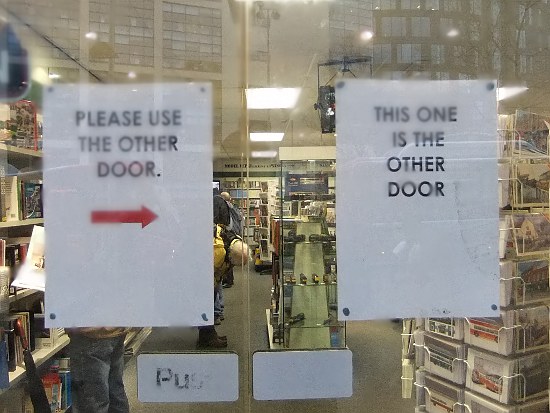 Sept 13, 2023–The world is a giant maze and we are all rats.
Sept 13, 2023–The world is a giant maze and we are all rats.
I came to this conclusion while sitting in my car watching people navigate. We are very predictable in our behavior.
Opening Doors
People entering buildings with double doors do three things every time:
1) Always first try the door on their right
2) If it is a C-shaped handle, they grab the top
3) Pull
If any of part of this routine is altered, the rat gets flustered.
1) Choosing the “right” double door
First, I will never understand why EVERY public building with two doors keeps one locked. Why? Is it just too much effort to unlock two doors every morning? Is it to control the incoming tsunami of customers buying “thinking of you” greeting cards? Is it to save wear and tear on one set of hinges? If you don’t need two doors to handle traffic, why did the builder install them?
Heaven forfend if the custodian unlocks the lefthand door by mistake. Arms will be dislocated when people yank the wrong door and it doesn’t move.
2) C-shaped handles
Everyone grabs the top of the handle. Just look at the wear patterns. I’m not a germaphobe, but I always grab the lowest part of the C-handle to open the door. No one ever touches that part.
3) Pull
If you want to upset customers, make your outer door an “innie” rather than “outie.” At the library in Fredericksburg, for some reason the beautiful exterior doors push in rather than pull out. I can tell who is not a regular patron by watching them struggle to pull open the library door. It still vexes me at times when I’m rushing in to avoid a 10-cent fine.
Why do exterior doors on commercial or public buildings swing outward, while doors on our homes swing inward? Does anyone know?
Parenthetically, the shape and placement of the door handle also fools users. There is a building that has installed those C-shaped handles on both inside and outside of the doors. Subconsciously, when we see a C-shaped handle, our brain commands us to “pull,” EVEN WHEN A RED PERMANENT MARKER SIGN YELLS “PUSH!” We are animals, functioning on ritual and instinct.
Turning Left
A long-time motorcycle instructor once told me every single beginning rider has an easier time making left-hand turns than right-hand turns. I was skeptical, but other riders and coaches confirmed it. Try it yourself on your bicycle, motorcycle, or walker. Turning left is easier. Why is this? Is it cultural, as in Americans run, race, and ride on counter-clockwise tracks? Is it because drivers sit on the left side of the vehicle. Is it anatomical? Is it a left-right brain thing? Are we not, after all, truly symmetrical?
Bumping into each other
When you are walking in a crowd, are you ever caught in the “sidewalk two-step?” That is the embarrassing dance where you and the approaching walker both choose to step sideways in the same direction, only to reverse direction at the same time. Carried to its end, you both stop directly in front of each other. In movies, the other person is always attractive and this leads to a date. In real life, you mumble apologies and slink off in a random direction you didn’t intend to go.
I used to wonder why this happens. I figured out it is all in the eye contact. When an opposing force approaches us in the guise of pedestrian, we look at their eyes to seek clues as to which way they will juke. They are doing the same to us. But we must be horrible at this, because usually we choose simultaneously to step in the same direction. The solution is simple: Break eye contact, and stare at a far-off object or look at your feet. Then just keep plowing ahead on your same path. The other person recognizes you as a blind ship on a set vector and they take the necessary steps to avoid a collision. THIS WORKS EVERY TIME.
The only drawback in using this technique is that you’ll never get to date them.